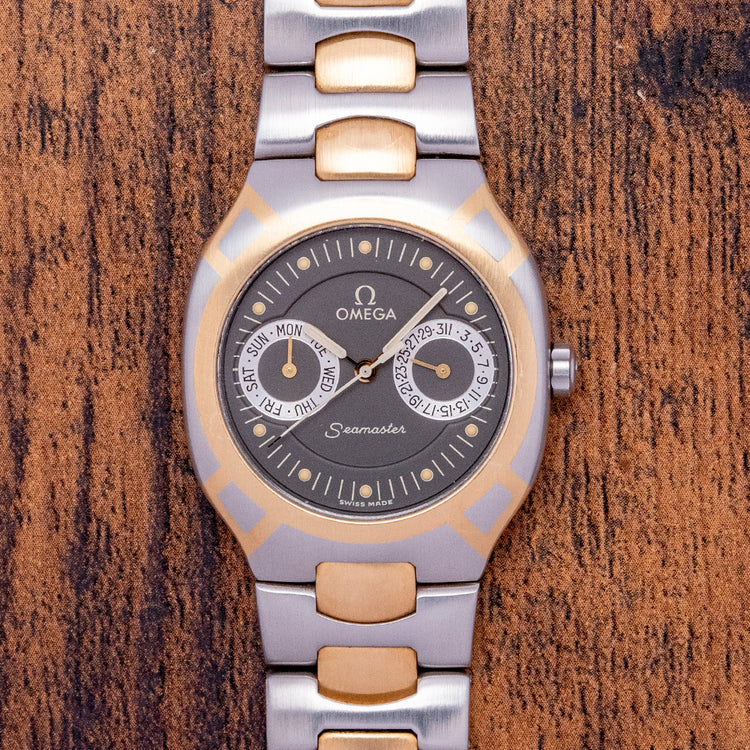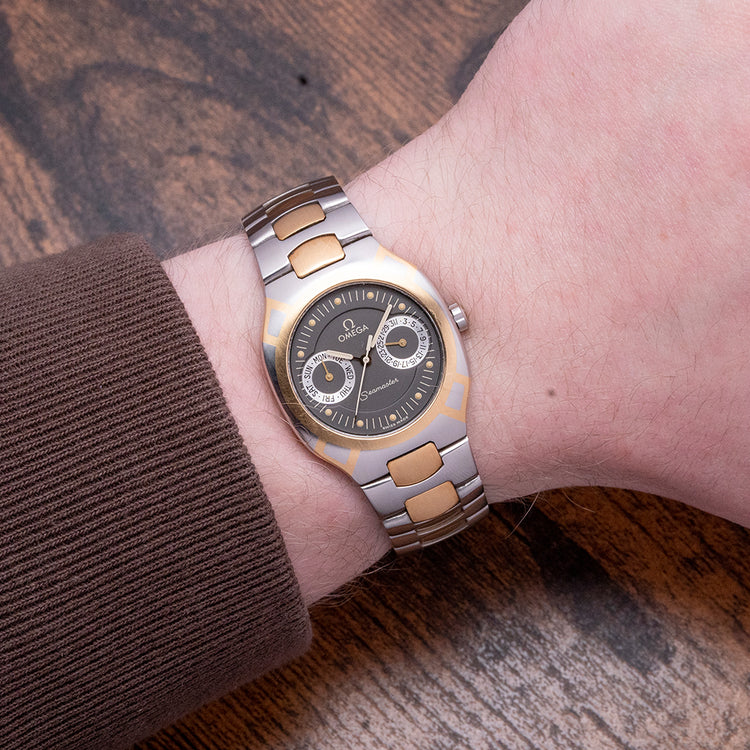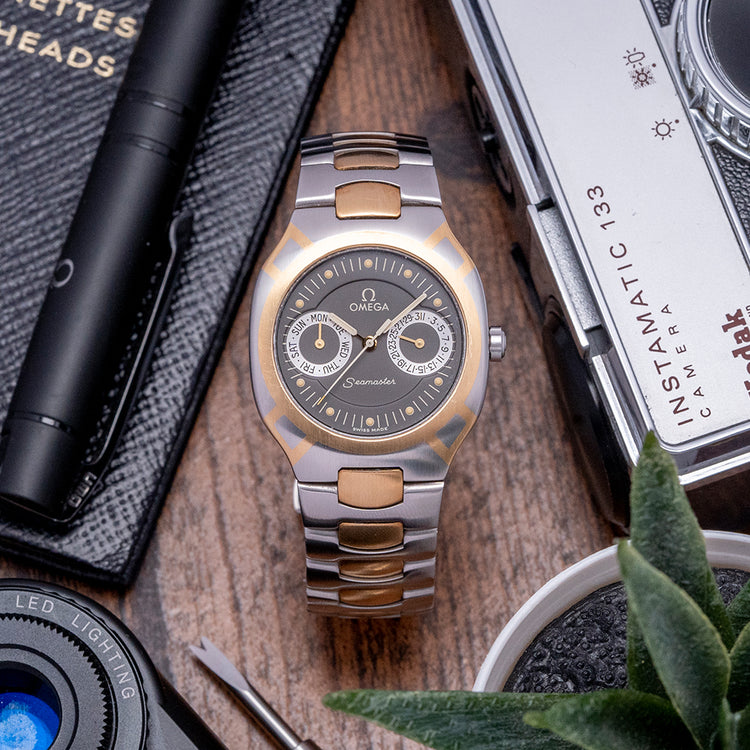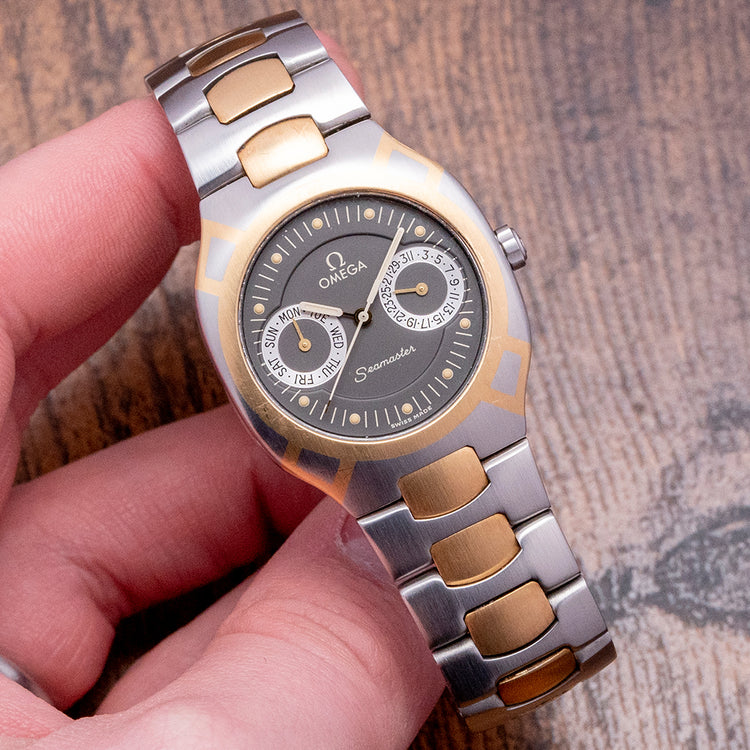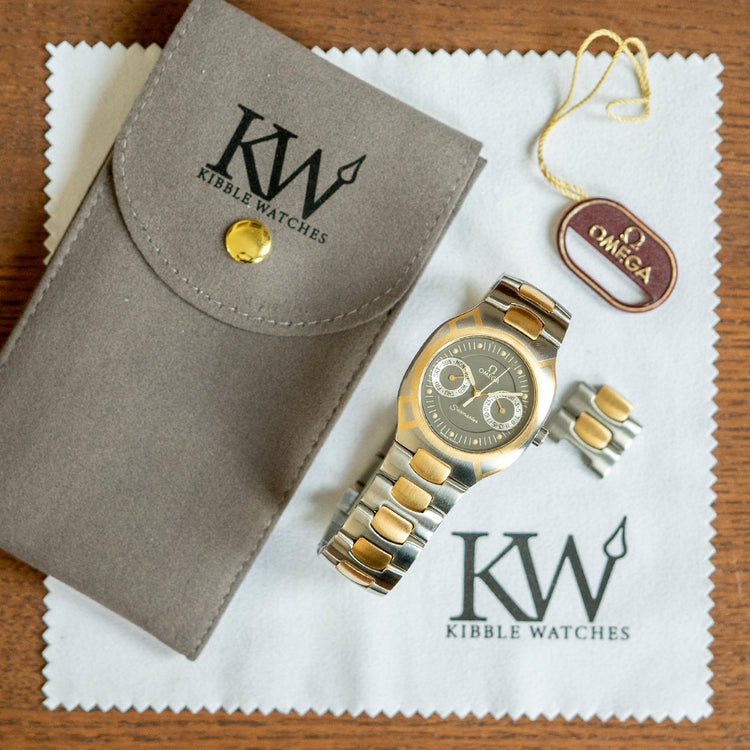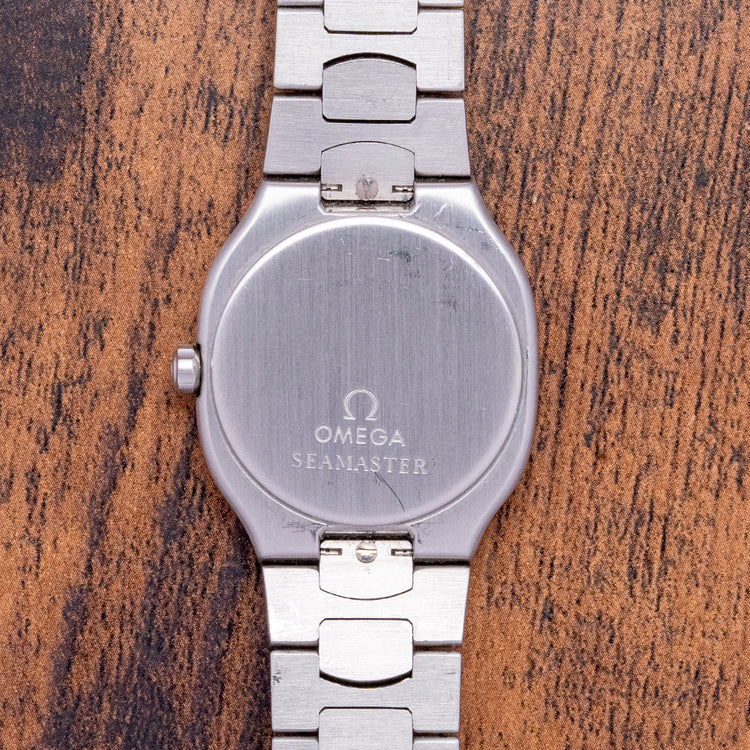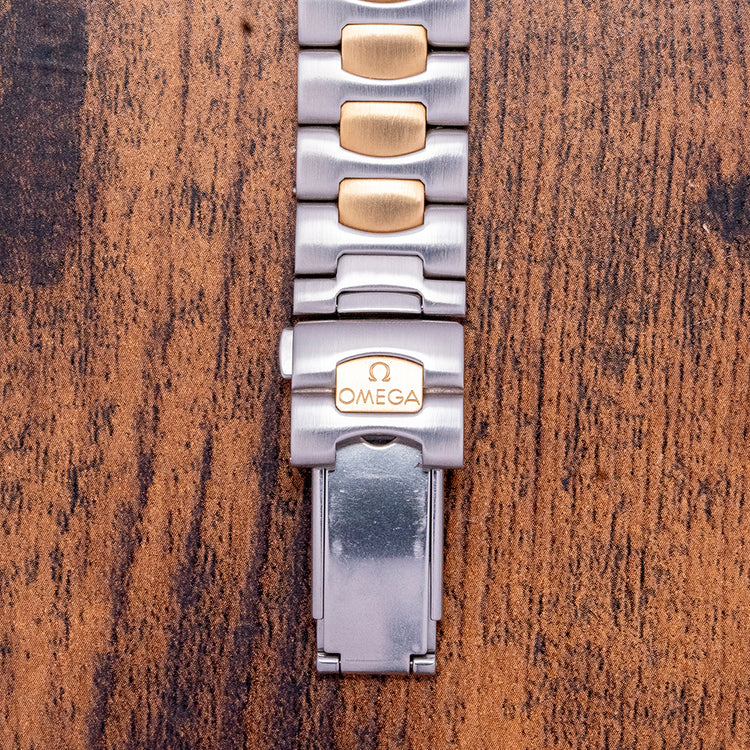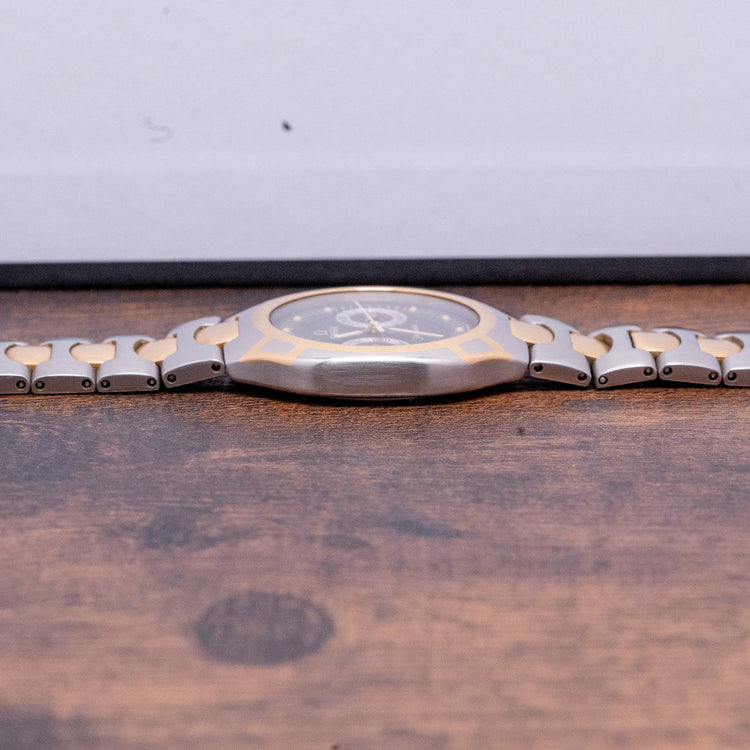More Information
Description
More
Less
The Watch
Here we have a 1986 Omega Seamaster Polaris Two-Tone Owl Dial on a Bracelet 396.1022 with a 31.5mm brushed stainless steel cushion-shaped case that flows over your wrist thanks to the integrated H-Link bracelet, and a lug-to-lug length of 42mm and a case thickness of just 6.5mm ensure a comfortable fit. On the right side is a signed crown and the gold geometric-shaped bezel surrounds a flat crystal above the affectionately named “Owl Dial” due to the bicompax arrangement. A raised outer minute chapter ring has lume surrounding a day register and date register, outlined in silver with black markings and gold-toned hands. Slender baton hands filled with lume are complemented by a tapered second hand, at 12 o’clock we have the Omega motif and at 6 o’clock “Seamaster” completes this striking timepiece. On the reverse, a snap-off brushed case back engraved with Omega Seamaster, inside a quality Quartz Omega Cal. 1445 movement, 6 jewels with a base of the ETA 255.451. The watch comes paired with its Omega 18mm H-link steel and gold integrated bracelet and signed concealed deployant clasp, links are provided and will fit up to a 7.15-inch wrist, including the watch's swing tag.
Points of Mention
This watch is sold as "Watch Only" and therefore comes with no Omega box or Omega paperwork. The watch comes paired with its two-tone Omega 18mm H-link integrated bracelet and signed concealed deployant clasp, links are provided and will fit up to a 7.15-inch wrist, including the watch’s swing tag. The watch is from Circa. 1986 and is in worn vintage condition, with age-related wear, as you can see and comes with our 12-Months NON-Waterproof Warranty.
For more photos see here - https://drive.google.com/drive/folders/1uz_A2UNnoX27NSkyBopK2J6-buBpshSn?usp=drive_link
4K YouTube video, skip to 24:58 - https://youtu.be/4WzLbj9lrew
Personal Note
The Omega Seamaster Polaris has been a love/hate watch for most collectors for some time, this is down to the design. But when I look at this watch and reference, I think Omega were clearly ahead of the curve and I hope one day they bring this back as it is wonderful on the wrist! I would not hesitate to add this to your collection, this is a wonderful example in great condition ready to be worn and enjoyed.
Specification
Lugs : 18mm (Integrated)
Condition : Pre-Owned
Box & Papers : None
Case Material : Stainless Steel & Gold
Warranty : 12-Months NON-Waterproof Warranty
The Brand
They were formerly known as the La Generale Watch Co. in 1848 founded by Louis Brandt in La Chaux-de-Fonds. When he died in 1879, his sons carried on his dream. In 1880 they moved to 96 Rue Jakob-Stampfli where they remain today. The brothers produced their first mass-produced calibre, the Labrador In 1885. Just a few years later in 1892, they produced the first minute-repeater. In 1903 they renamed the company Omega until 1982 when they officially changed their name to Omega SA. During WW1 Omega watches were used as official timekeepers for the Royal Flying Corps and the US Army. In 1930, Omega and Tissot merged together to form Société Suisse pour l'Industrie Horlogère (SSIH) In 1931, another group was formed - Allgemeine Schweizerische Uhrenindustrie AG (ASUAG). Where SSIH was primarily French-speaking, ASUAG was founded by the more German-speaking members of the Swiss watch industry. In 1948 they introduced the first edition of one of its most symbolic watches: the Seamaster. Omega first introduced the Constellation in 1952. At the time it was Omega's flagship timepiece. The first models had a Cal. 354 bumper movement in them. Later in 1955, Omega introduced the Automatic Cal. 50x, followed in 1959 by the Cal.55x (no date) and 56x (date) versions. Many of the Constellations came with pie-pan dials, diamond indexes, and fancy lug configurations. All the gold Constellations of that time have the Observatory of Geneva's hand engraved on the back. The stainless steel and stainless steel/gold versions had a gold medallion on the back with the Observatory of Geneva. The eight stars above the Observatory stand for the many exploits of Omega in the world Chronometer competition. Celebrating the fact that all Constellations are Chronometer Certified. In 1962, when astronaut Wally Schirra wore a Speedmaster on his Mercury Sigma 7 Mission, making it the first Omega watch to enter space. After rigorous tests, NASA used Omega for all their Apollo missions including the 1969 Moon landing of Apollo 11. Today Omega is still an astronaut's first choice. In 1969, President Nixon famously said it was “too valuable” and turned down the first-ever all-gold Speedmaster Professional Deluxe. As a response to the ever-growing threat of electronic watches to the manufacturers of mechanical watches, Omega and many Swiss brands such as Rolex and Patek Philippe formed Centre Electronique Horologer (CEH). Prototypes began to appear in 1967 with their production starting in 1968. Then In 1972, Omega introduced the reference, 198.030, which included the Omega calibre 1250, a ‘tuning-fork electronic movement which was made under licence from Bulova. Later we saw a merger of SSIH and ASUAG into SMH, or Société de Microélectronique et d’Horlogerie. This merger took place in 1983. In 1992, the company acquired Blancpain, and in 1998 it officially rebranded itself from SMH to the Swatch Group. Then, in 1999, they purchased and integrated Breguet into the Swatch Group.
Points of Mention
More
Less
Personal Note
More
Less
Specification
More
Less
Movement : Quartz Omega Cal. 1445
Year : 1986
Case Size : 31mm
Case Thickness : 6.5 mm
Lug to Lug : 42mm
Condition : Pre-Owned
Box and Papers : None
Warranty : 12-Months NON-Waterproof Warranty
The wrist model's wrist size is 7inch
About Omega
More
Less
Description
The Watch
Here we have a 1986 Omega Seamaster Polaris Two-Tone Owl Dial on a Bracelet 396.1022 with a 31.5mm brushed stainless steel cushion-shaped case that flows over your wrist thanks to the integrated H-Link bracelet, and a lug-to-lug length of 42mm and a case thickness of just 6.5mm ensure a comfortable fit. On the right side is a signed crown and the gold geometric-shaped bezel surrounds a flat crystal above the affectionately named “Owl Dial” due to the bicompax arrangement. A raised outer minute chapter ring has lume surrounding a day register and date register, outlined in silver with black markings and gold-toned hands. Slender baton hands filled with lume are complemented by a tapered second hand, at 12 o’clock we have the Omega motif and at 6 o’clock “Seamaster” completes this striking timepiece. On the reverse, a snap-off brushed case back engraved with Omega Seamaster, inside a quality Quartz Omega Cal. 1445 movement, 6 jewels with a base of the ETA 255.451. The watch comes paired with its Omega 18mm H-link steel and gold integrated bracelet and signed concealed deployant clasp, links are provided and will fit up to a 7.15-inch wrist, including the watch's swing tag.
Points of Mention
This watch is sold as "Watch Only" and therefore comes with no Omega box or Omega paperwork. The watch comes paired with its two-tone Omega 18mm H-link integrated bracelet and signed concealed deployant clasp, links are provided and will fit up to a 7.15-inch wrist, including the watch’s swing tag. The watch is from Circa. 1986 and is in worn vintage condition, with age-related wear, as you can see and comes with our 12-Months NON-Waterproof Warranty.
For more photos see here - https://drive.google.com/drive/folders/1uz_A2UNnoX27NSkyBopK2J6-buBpshSn?usp=drive_link
4K YouTube video, skip to 24:58 - https://youtu.be/4WzLbj9lrew
Personal Note
The Omega Seamaster Polaris has been a love/hate watch for most collectors for some time, this is down to the design. But when I look at this watch and reference, I think Omega were clearly ahead of the curve and I hope one day they bring this back as it is wonderful on the wrist! I would not hesitate to add this to your collection, this is a wonderful example in great condition ready to be worn and enjoyed.
Specification
Lugs : 18mm (Integrated)
Condition : Pre-Owned
Box & Papers : None
Case Material : Stainless Steel & Gold
Warranty : 12-Months NON-Waterproof Warranty
The Brand
They were formerly known as the La Generale Watch Co. in 1848 founded by Louis Brandt in La Chaux-de-Fonds. When he died in 1879, his sons carried on his dream. In 1880 they moved to 96 Rue Jakob-Stampfli where they remain today. The brothers produced their first mass-produced calibre, the Labrador In 1885. Just a few years later in 1892, they produced the first minute-repeater. In 1903 they renamed the company Omega until 1982 when they officially changed their name to Omega SA. During WW1 Omega watches were used as official timekeepers for the Royal Flying Corps and the US Army. In 1930, Omega and Tissot merged together to form Société Suisse pour l'Industrie Horlogère (SSIH) In 1931, another group was formed - Allgemeine Schweizerische Uhrenindustrie AG (ASUAG). Where SSIH was primarily French-speaking, ASUAG was founded by the more German-speaking members of the Swiss watch industry. In 1948 they introduced the first edition of one of its most symbolic watches: the Seamaster. Omega first introduced the Constellation in 1952. At the time it was Omega's flagship timepiece. The first models had a Cal. 354 bumper movement in them. Later in 1955, Omega introduced the Automatic Cal. 50x, followed in 1959 by the Cal.55x (no date) and 56x (date) versions. Many of the Constellations came with pie-pan dials, diamond indexes, and fancy lug configurations. All the gold Constellations of that time have the Observatory of Geneva's hand engraved on the back. The stainless steel and stainless steel/gold versions had a gold medallion on the back with the Observatory of Geneva. The eight stars above the Observatory stand for the many exploits of Omega in the world Chronometer competition. Celebrating the fact that all Constellations are Chronometer Certified. In 1962, when astronaut Wally Schirra wore a Speedmaster on his Mercury Sigma 7 Mission, making it the first Omega watch to enter space. After rigorous tests, NASA used Omega for all their Apollo missions including the 1969 Moon landing of Apollo 11. Today Omega is still an astronaut's first choice. In 1969, President Nixon famously said it was “too valuable” and turned down the first-ever all-gold Speedmaster Professional Deluxe. As a response to the ever-growing threat of electronic watches to the manufacturers of mechanical watches, Omega and many Swiss brands such as Rolex and Patek Philippe formed Centre Electronique Horologer (CEH). Prototypes began to appear in 1967 with their production starting in 1968. Then In 1972, Omega introduced the reference, 198.030, which included the Omega calibre 1250, a ‘tuning-fork electronic movement which was made under licence from Bulova. Later we saw a merger of SSIH and ASUAG into SMH, or Société de Microélectronique et d’Horlogerie. This merger took place in 1983. In 1992, the company acquired Blancpain, and in 1998 it officially rebranded itself from SMH to the Swatch Group. Then, in 1999, they purchased and integrated Breguet into the Swatch Group.
Points of Mention
Personal Note
Specification
The Brand
Enquire or Book an Appointment
Would you like to discover further details about this watch, or perhaps arrange an appointment to view and try it on? Complete this form and a member of our team will get back to you shortly.
You May Also Like




















